A Private Tour in North Norfolk today. It was nice and dry all day, but a bit cloudy and cool in the W/NW breeze. That seemed to keep a cap on migration, although we still managed to see a nice selection of birds on the move and some early returning summer visitors.
Starting from Wells, we headed west along the coast. Our first stop was at Holkham where we were immediately watching Spoonbills in the tops of the trees. There were two in view at first, one looked to be trying to gather sticks, pulling at thin branches, presumably busy nestbuilding. Periodically they would fly round and drop back into the trees out of view, with the same or another then coming back up into the tops. When perched high in the trees, through the scope we could see their spoon-shaped bills. There were lots of Cormorants in the trees too.
Another large white shape appeared out of one of the ditches further over, a Great White Egret. It quickly took off and flew across in front of us, landing down out of view again. In flight, we could see its large size, and heavy flight on long broad bowed wings. A short while later, it flew again and disappeared down behind some reeds further west.
Despite the cool temperature, there was plenty of raptor activity. A shrill call above alerted us to the presence of a displaying Marsh Harrier. We watched as it tumbled down out of the sky and dropped into the reeds. A female Marsh Harrier appeared out of the reeds away to our left and flew up into a tree. When we got it in the scope, we could see a Common Buzzard in the tree behind, perched waiting for the air to warm up a bit. The female Marsh Harrier then dropped down to the ground in front of the reeds and flushed a second male Marsh Harrier out of the grass, presumably a pair.
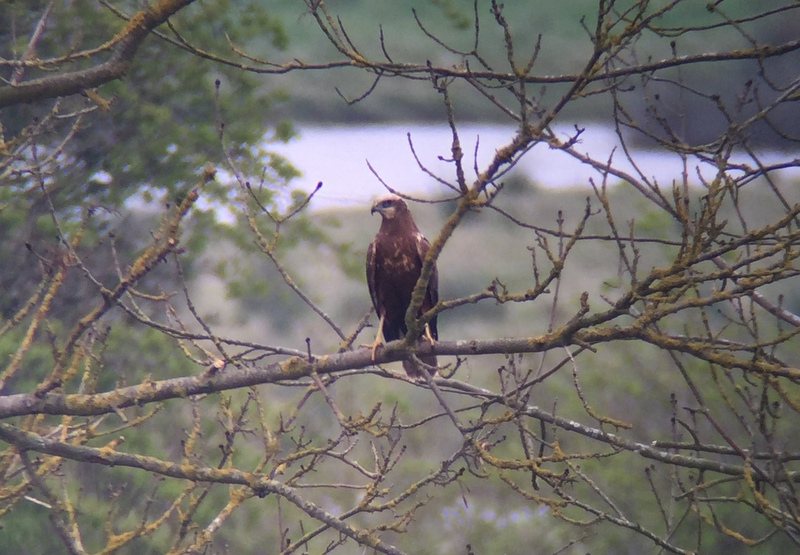 Marsh Harrier – the female perched in a tree
Marsh Harrier – the female perched in a tree
Most of the geese down on the grazing marshes are Greylags now, with the majority of the winter geese having departed north already, en route to their breeding grounds. Scattered among them, we found a few Egyptian Geese, a Canada Goose and a single Pink-footed Goose. The latter appeared to have an injured wing – a few sick or injured Pink-footed Geese remain year round at Holkham, normally birds which have been shot and wounded and are unable to complete the journey back to Iceland.
A larger group of geese were feeding on the grass on the fort. Through the scope we could see that they were mostly Pink-footed Geese too, about 30-40 of them. These are just the laggards, with no excuse for not heading off, they are just awaiting suitable conditions to make the journey.
Our next stop was at Titchwell. A couple of Chiffchaffs and a Blackcap were singing from the trees around the car park, our earliest returning summer warblers. The tame local Robins came straight over to the car as we got out, hoping for a very early lunch! Round at the visitor centre, the winter finches appear to have departed now, but we still managed to add Chaffinch, Goldfinch and Greenfinch to the day’s list, at the feeders.
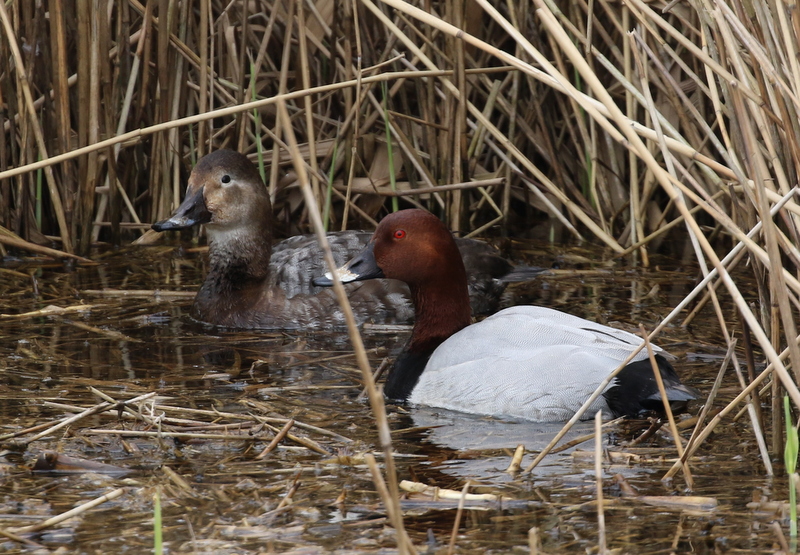 Common Pochard – a pair in the pools by the main path
Common Pochard – a pair in the pools by the main path
As we walked out along the main path, the dried up grazing meadow ‘pool’ appeared deserted. On the other side, a pair of Common Pochard were feeding around one of the small pools by the path, the male closely shepherding the female. Looking around the larger reedbed pool, we could see three Red-crested Pochard lurking on the edge of the reeds. Through the scope, we could see the coral red bills of the two drake, and their orange punk hairstyles.
We could hear Bearded Tits calling from the reeds nearby, but they were hard to see today. Given the chill in the breeze, they were keeping low. Occasionally, one would climb up a reed stem briefly, before dropping back into cover, and eventually we all managed to get a look at one. We decided to have another look on the way back, hoping it might have warmed up a little.
As we waited for the Bearded Tits to show themselves, we were aware of several little groups of finches flying west. They were Linnets and Goldfinches, on their way north, following the coast round. A couple of little groups of Meadow Pipit flew over too. Great to see migration in action, despite the cooler weather.
The water levels of the Freshmarsh are still quite high at the moment, which means that not much mud is exposed. Consequently, there were few waders on here today, and rather more ducks. Several Teal were feeding along the edge by the path, the drakes looking very fine at the moment. There were also good numbers of Shoveler and a few Shelduck out on the water.
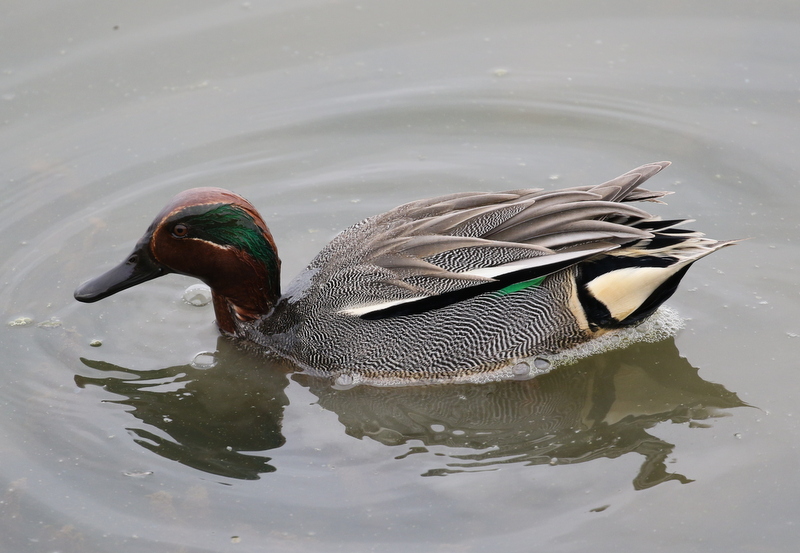 Teal – the drakes are looking very smart now
Teal – the drakes are looking very smart now
The waders were mainly represented by Avocets. A few were sleeping out in the shallow water around one of the submerged islands in the middle, but others were feeding, either up to their bellies in the deeper water or around the edge. It was clear that many were already paired up, the birds out feeding mostly in twos.
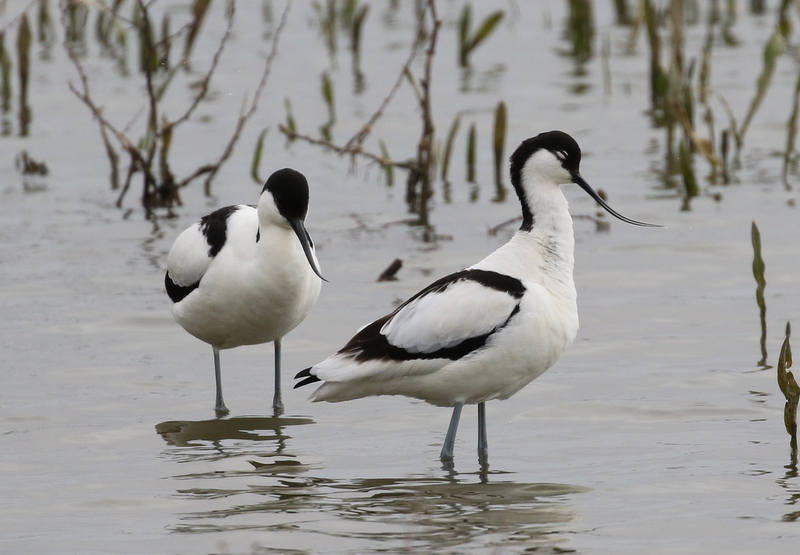 Avocets – many are paired up already
Avocets – many are paired up already
There were a few Black-tailed Godwits out on the Freshmarsh, but by the time we got to Parrinder Hide they had flown off. A quick scan of the lower islands which were not underwater revealed a single Little Ringed Plover, but unfortunately that flew off over the bank before we could all get a look at it through the scope. Little Ringed Plovers are summer visitors, so this was another early returning bird. The Ruff were more amenable, with several feeding in the grass on the fenced off island, among the Black-headed Gulls.
From the hide, we could see a few lingering Wigeon around the islands. Most appear to have departed already, on their way back to Russia to breed. A pair of Gadwall were feeding just outside the hide and another pair of Red-crested Pochard were sleeping further out. A couple of Meadow Pipits dropped in along the edge for a quick feed and drink, possibly more migrants stopping off briefly on their way.
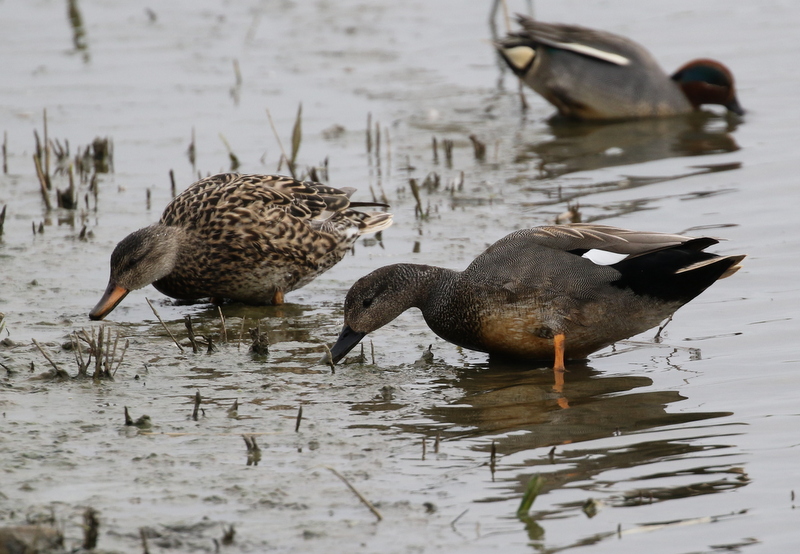 Gadwall – a pair feeding out from Parrinder Hide
Gadwall – a pair feeding out from Parrinder Hide
The Volunteer Marsh was mostly quiet – with small tides at the moment, the surface was mainly dry. Only around the lower lying channel around the far edge did we find a few Redshanks, a couple of Curlew and a single Grey Plover which was very well camouflaged against the mud.
There were more waders out on the Tidal Pools. The Black-tailed Godwits were on here feeding in the shallower water, several now getting into their brighter orange summer plumage. More Avocets were sleeping on the spit towards the back and in with them we found two smaller, pale grey Knot, also asleep.
 Black-tailed Godwit – now moulting into orange summer plumage
Black-tailed Godwit – now moulting into orange summer plumage
A pair of Shoveler were asleep right by the path, and the drake helpfully awoke briefly as we walked past and flashed its enormous bill, having a quick yawn, before going back to sleep. Yet another two Red-crested Pochard were asleep on the island here – there seem to be a lot of them back here now.
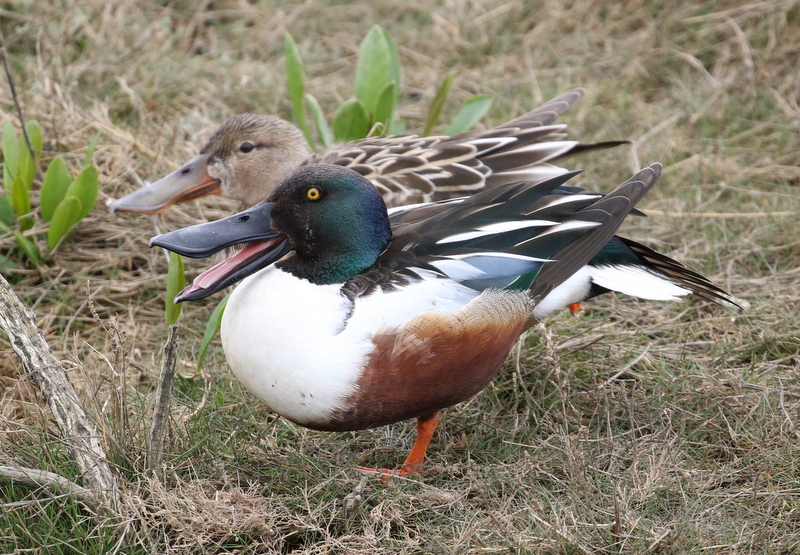 Shoveler – a pair, the drake showing off its enormous bill
Shoveler – a pair, the drake showing off its enormous bill
Out on the beach, we could see a long oil slick of black ducks out the sea, Common Scoters. Through the scope we could see the black drakes and the browner females. There were still several hundred offshore here today, some closer in but a larger raft a bit further out. In with the closer ones, we could see several Long-tailed Ducks, including one or two handsome drakes. It was nice to see several of these winter visitors still lingering, it has been a good winter for them here, though presumably they should also soon be departing north. Scanning through the Common Scoter we counted at least 35 Long-tailed Ducks still here today.
 Long-tailed Ducks – at least 35 were still on the sea today
Long-tailed Ducks – at least 35 were still on the sea today
Also out on the sea, we found a few Great Crested Grebes still. There were quite a few gulls offshore, particularly hassling the larger raft of Common Scoter. Three paler, slimmer winged birds which flew past closer inshore were Sandwich Terns, early returning birds back for the breeding season.
Down on the mussel beds, there were lots of Oystercatchers. A closer look also revealed a small party of Knot and a good number of Turnstone hidden in the seaweed. Further along the beach towards Brancaster, there were still a few Bar-tailed Godwits in with the other waders, but numbers of there have declined now as we get into spring.
It was a bit fresh out on the beach, so we decided to make our way back. As we turned to leave the beach, a large group of Brent Geese flew in over the beach and headed towards the reserve. When we got back to the Freshmarsh, they were all out on the water, chattering to each other. Yet more lingering winter visitors, they should soon be on their way back to Russia to breed.
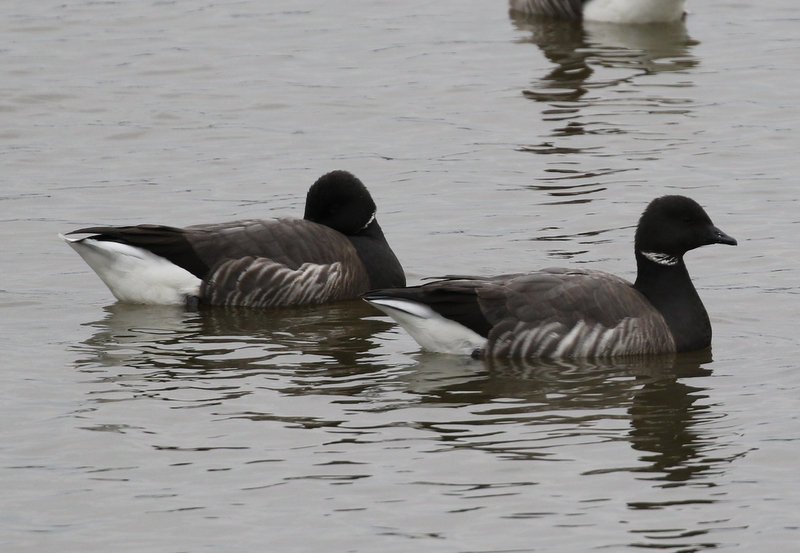 Brent Geese – flew in to the Freshmarsh from the beach
Brent Geese – flew in to the Freshmarsh from the beach
A stop to scan the Freshmarsh, revealed not one but three Little Ringed Plovers now out on the islands. We got one in the scope and had a look at it. As we were scanning through the gulls, we picked up two paler birds flying in over the bank from the direction of Brancaster. A pair of Mediterranean Gulls, they dropped down into the fenced off island amongst the Black-headed Gulls and started displaying. Through the scope, we could see the Mediterranean Gulls’ more extensive, jet black hoods and white wing tips.
We stopped for a rest on the bench back by the reedbed, but at first their was no sound of any Bearded Tits. Then we spotted one flying across one of the reedy channels, and then back again. A closer look revealed a pair of them feeding in the reeds along the edge. We even managed to get the male in the scope briefly.
A quick scan of the grazing meadow ‘pool’ on the way back revealed a single wagtail out on the dry mud. It was noticeably paler than the Pied Wagtails we had seen earlier, with a silvery grey back contrasting with its black cap, a White Wagtail. White Wagtails are passage migrants through here, on their way north to Iceland or Scandinavia, a nice bird to see.
After a late lunch back at the visitor centre, with a welcome hot drink to warm us up, we started to make our way back east. We called in briefly at Brancaster Staithe, but there was a lot of disturbance here today. That didn’t seem to deter the Turnstones which were still running around in and out of the cars.
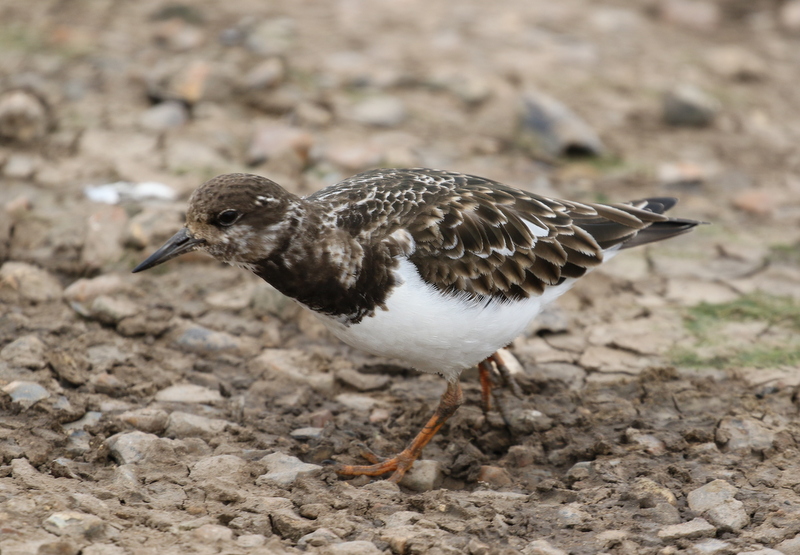 Turnstone – running around the car park, despite the disutrbance today
Turnstone – running around the car park, despite the disutrbance today
Our next stop was at Burnham Norton. There has been a Green-winged Teal here for several days now and another couple of local birders quickly located it for us half hidden in a small pool out on the grazing meadow, while we were admiring a Mistle Thrush out on the short grass. From round on the bank the other side, with a bit mroe elevation, we had a great view of the Green-winged Teal.
The North American cousin of our (Eurasian) Teal, Green-winged Teal differs principally in having a bold white vertical stripe on the foreflank and lacking the white horizontal stripe above the flanks which our Teal shows. Helpfully, there was even a drake Teal nearby for comparison!
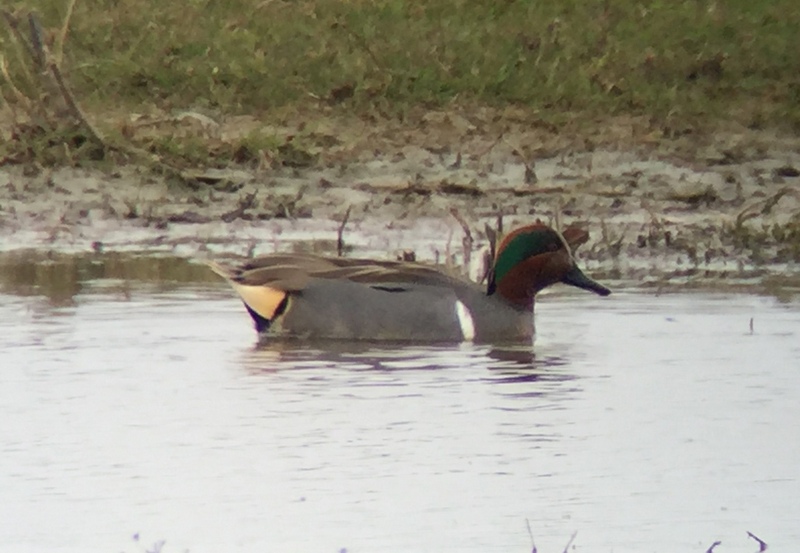 Green-winged Teal – a drake, showing off its bold white vertical flank stripe
Green-winged Teal – a drake, showing off its bold white vertical flank stripe
There was lots of other avian action here while we were watching the Green-winged Teal. Two Swallows flew west, the first we have seen in Norfolk this year. A Sedge Warbler was singing away from the reeds behind us, another early returning summer visitor. A drake Garganey flew up from one of the ditches, but unfortunately dropped down again out of view before anyone could get onto it. We had a look along the ditch where it landed, but we couldn’t see it in there in the open water and it had probably disappeared into the reeds.
The Marsh Harriers provided another highlight. We could hear one calling and looked up to see a male displaying high overhead, swooping and tumbling. It gradually lost height and dropped down steeply into the reeds. The next thing we knew a second male Marsh Harrier appeared and the two of them proceeded to chase each other round over the reedbed, while a female circled nearby.
 Marsh Harriers – two grey-winged males, chasing each other round the reedbed
Marsh Harriers – two grey-winged males, chasing each other round the reedbed
We made our way inland, through farmland, back to Wells. A couple of Red Kites circled over the fields and we also saw a few Kestrels on the way, our first of the day. A brief stop produced a couple of Brown Hares in a field and several Red-legged Partridges to add to the day’s list. Then it was time to head for home. Despite the cool weather, we had seen several reassuring signs today that spring is here, with several warblers back and singing, and birds on the move.
















